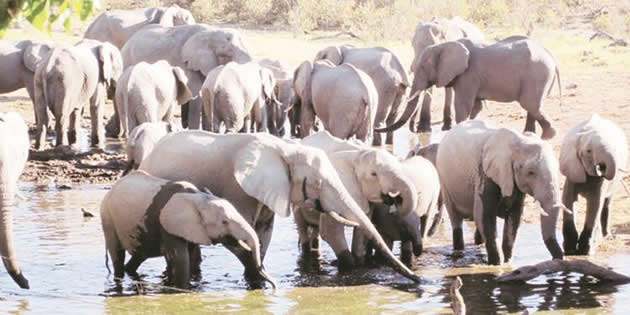Elephants destroys crops in Namibia

WINDHOEK. – Hopes of farmers in northern Namibia’s Ondjungulume village for a bumper harvest are being dashed, following the invasion of elephants at the village.
For the past three weeks, the elephants have been destroying crops and homesteads at the village.
The elephants strayed to Ondjungulume village from Ruacana in search for water and greener pasture, according to Chief Control-Warrant for the northern regions Rehabeam Erkki.
“The elephants are drawn to the area by the good rains received,” Erkki said.
Valeria Namboga from Ondjungulume village in the Otamanzi Constituency in Omusati region has been farming pearl millet and sorghum there for over 10 years.
Hard hit by a dry spell over the years, the region recently received good rainfall. “The good rainfall received gave us hope for better and improved faring season,” said Namboga.
But her hopes for a better yields are being shuttered by elephants that invaded her field and destroying her crops. Namboga said the wild animals have visited and destroyed her crops three days in a row.
“They are destroying my crops and disturbing our farming routine,” Namboga bemoaned.
That is not all. Not only are the elephants destroying their crops, but the villagers are living in fear as the wild animals are also terrorising their homesteads. Paulus Nuyoma, a chief from the village leadership, said that the animals are putting their lives in danger.
“They are vandalising our villagers’ fences and homes. This has a negative impact on our people’s livelihood,” he said.
As part of interventions, Erkki explained that, through the Ministry of Environment and Tourism, the regional team had dispatched nature conservation officials to monitor the behavior and movement of the elephants to prevent them from destroying any more crops.
But villagers are not satisfied about the arrangement and said that the monitoring officials are not doing much to prevent the elephants from damaging the crops.
According to Namboga, although nature conservation officials in the region have stepped in; and are herding the elephants during the day to scare them off them off, at night, the elephants wander freely and still destroy the crops.
“We endured a dry spell, and our last hope for recovery is being threatened. This human-wildlife conflict is costing us our livelihood that we are striving to re-build after a long period of drought,” vented Namboga.
In the meantime, the villagers are appealing to the Ministry of Environment and Tourism and nature conservation officials to come up with more hands-on interventions to remove the elephants from the village before it is too late.
“They should remove the elephants from the area before more damage is done,” Namboga said.
Information from the Ministry of Environment and Environment shows that the major problems of conflicts between wildlife and human activities takes place on communal land, where predators and most elephants stray outside protected areas.
Human-wildlife conflict is also experienced on commercial farmers given that more than 40 percent of the land use in Namibia dedicated to commercials farming. – Xinhua.










Comments